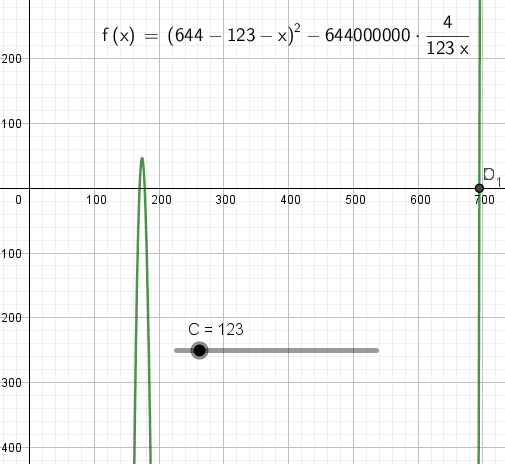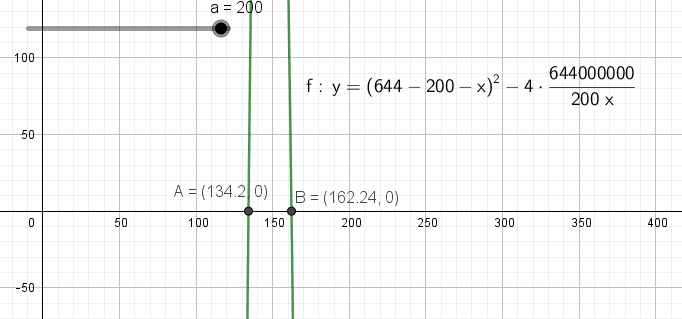There are three items at a grocery store whose prices are interesting: the addition of them and the multiplication of them are exactly the same. For example, Now, there are also four items with prices such that If what is the value of
The answer is 59.
This section requires Javascript.
You are seeing this because something didn't load right. We suggest you, (a) try
refreshing the page, (b) enabling javascript if it is disabled on your browser and,
finally, (c)
loading the
non-javascript version of this page
. We're sorry about the hassle.
Let A = 1 0 0 a , B = 1 0 0 b , C = 1 0 0 c and D = 1 0 0 d . Then we have A + B + C + D = 6 4 4 and A B C D = 6 4 4 0 0 0 0 0 0 .
Since ( u + v ) 2 − 4 u v = ( u − v ) 2 ≥ 0 , we have ( A + B ) 2 − 4 A B = ( 6 4 4 − C − D ) 2 − 4 × C D 6 4 4 0 0 0 0 0 0 ≥ 0 .
Sketch the graph y = ( 6 4 4 − C − x ) 2 − 4 × C x 6 4 4 0 0 0 0 0 0 . Using geogebra, we know that 0 < y < 6 4 4 if 1 2 3 ≤ C ≤ 2 0 3 .
Now consider the factors w of 6 4 4 0 0 0 0 0 0 = 7 × 2 3 × 2 8 × 5 6 , where 1 2 3 ≤ w ≤ 2 0 3 . We have w ∈ { 1 2 5 , 1 2 8 , 1 4 0 , 1 6 0 , 1 6 1 , 1 7 5 , 1 8 4 , 2 0 0 } .
Note that, if we choose C = 1 6 1 = 2 3 × 7 , then A , B , D ∈ / { 1 4 0 , 1 7 5 , 1 8 4 } as each of these numbers has either 7 or 23 as factor. Similarly, we pick exactly one element from { 1 4 0 , 1 7 5 } as both have 7 as factor.
Note that if C = 1 2 8 = 2 7 , then A , B , D ∈ / { 1 4 0 , 1 6 0 , 1 8 4 , 2 0 0 } otherwise A B C D has a factor 2 k where k > 8 . This means that if C = 1 2 8 = 2 7 , then A , B , D ∈ { 1 2 5 , 1 6 1 , 1 7 5 } which is not possible as 1 6 1 and 1 7 5 appear simultaneously. So 1 2 8 is not in the consideration.
Note that if C = 1 6 1 , then A , B , D ∈ { 1 2 5 , 1 6 0 , 2 0 0 } which is not possible as A + B + C + D = 6 4 4 . So 1 6 1 is not in the consideration.
So A , B , C , D ∈ { 1 2 5 , 1 4 0 , 1 6 0 , 1 7 5 , 1 8 4 , 2 0 0 }
Using geogebra again, we know if C = 2 0 0 , 1 3 4 < x ≤ 1 6 2 , so from the above list, A , B , D ∈ { 1 4 0 , 1 6 0 } which is not possible. So 2 0 0 is not in the consideration.
So either A , B , C , D ∈ { 1 2 5 , 1 6 0 , 1 7 5 , 1 8 4 } or A , B , C , D ∈ { 1 2 5 , 1 4 0 , 1 6 0 , 1 8 4 } .
After checking, A = 1 2 5 , B = 1 6 0 , C = 1 7 5 and D = 1 8 4 satisfy the condition.
So 1 0 0 ( d − a ) = D − A = 1 8 4 − 1 2 5 = 5 9 .